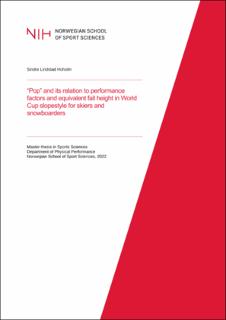| dc.description.abstract | Purpose: The aim of this study was to measure and investigate the “pop” performed by elite athletes in slopestyle skiing and snowboarding. Pop refers to the action an athlete performs at the end of the kicker (at the point of take-off), where an extension or contraction movement as a result of muscular work is used to adjust the take-off angle.
Methods: 273 individual trials were measured on three roll-over / step-up jumps during a slopestyle World Cup competition where male and female skiers and snowboarders participated. The snow surface was measured using a Lidar scanner, and jump profiles were derived from the data. A tachymetry-based video system (QDaedalus) along with computer vision were used to track and reconstruct the centre of mass trajectories. The trajectories and jump profile were used to calculate the parameters pop, jump distance, vertical jump height, velocity, take-off and landing angle, and equivalent fall height.
Results: In the 273 trials across the three jumps, pop ranged from -2.32 m/s to +2.20 m/s, where female skiers pop-ed at a mean of -0.29 m/s (± 0.71), male skiers at +0.07 m/s (± 0.71), female snowboarders at -0.17 m/s (± 0.66) and male snowboarders at +0.37 m/s (± 0.66). Skiers, snowboarders, female and male athletes landed at the same distance and approached the point of take-off with similar velocities. Snowboarder pop-ed 0.36 m/s more than skiers and male athletes pop-ed more than females. Males had longer flight time and higher vertical jump height compared with females, both in skiers and snowboarders. Furthermore, maximizing the pop was associated with both increased average angular velocity during flight, and flight time. At best there was a moderate negative relation between the velocity and pop (-0.546 within snowboarders), and the velocity and pop could only explain small parts (6.6%) of the variation observed in EFH. Adding landing angle to the model increased the explanatory power to 82.3%.
Conclusion: This study extends the knowledge on pop with data from elite athletes. Pop seems to be used as a tool to enhance performance through an increase in both flight time and average angular velocity / number of rotations to increase difficulty/progression and amplitude at the same time. Additionally, it was indicated that pop was used to regulate the jump distance to land in the “sweet spot”, and hence, optimize the landing impact, but pop had limited effect on EFH for the given jumps. | en_US |
